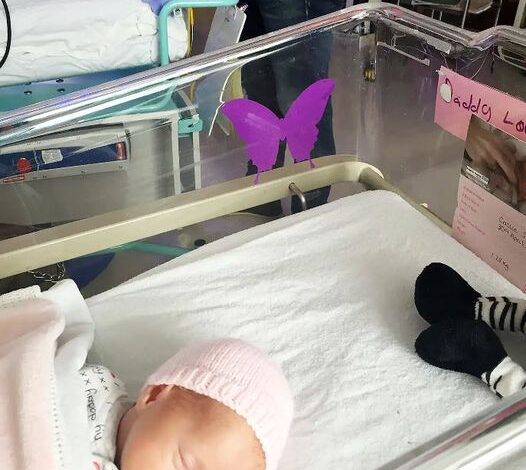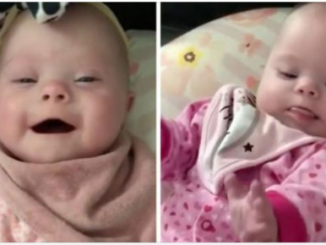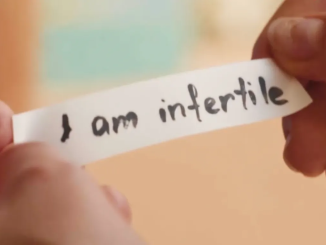
Only weeks after Millie Smith and Lewis Cann learned they were having twin baby girls, they learned that only one would survive.
On April 30, after 30 weeks of a high-risk pregnancy, Smith delivered identical twins, Callie and Skye, the latter who lived only three hours.
Later in neonatal intensive care unit (NICU), Callie slept without her sister in the incubator, with her loving and grieving parents watching over her. In the unit with other babies, an overwhelmed mom of healthy newborn twins innocently told Smith that she was “so lucky” to not have two babies.
Crushed by the words, the new mom couldn’t find the words to explain her loss. Then, she realized that Skye’s legacy was to help other families who lose a child, and it came in the form of a purple butterfly.
In November 2015 Millie Smith and partner Lewis Cann found out they were having their first Child. Smith, who has twins in the family, said she had a “gut feeling” about having a duo and 10 weeks later, doctors confirmed she was expecting identical twin girls.
Less than two weeks after the excitement of knowing they would double the children in their home, the British couple were devastated to learn that one of their babies had a fatal condition and wouldn’t survive after birth.
“During the scan, the doctor didn’t say anything. I was very excited and loved seeing the little babies, but she was silent. Both Lewis and I immediately knew there must be a problem,” Smith said.
Doctors shared the news that one of the babies had anencephaly, which according to the Centers for Disease Control and Prevention (CDC) affects about one in 4,600 babies across the U.S. It’s a serious birth defect where a baby is born without parts of the brain and skull, and “almost all babies born with anencephaly will die shortly after birth.”
Knowing that one baby would die soon after birth, and that there were risks involved for their other baby, the couple decided to move forward with the extremely high-risk pregnancy.
Over the next several months, Smith and Cann named their twins Skye and Callie. “We knew that Skye needed to have a name before she was born,” Smith said. “Knowing she would only survive for seconds or minutes, I wanted her to be named during that time.”
The meaning behind “Skye,” she explained “was somewhere we knew she would always be, that we could look up at the sky and remember our baby.”
When Smith went into labor after only 30 weeks on April 30, she needed an emergency C-section. To help navigate the loss, the couple had a “bereavement midwife” during the birth, and they were put I a special room the called the “Daisy Room,” where families can spend time with a baby before and after she/he passes.
“When the girls were born, they both cried. This was a huge moment, as we were told that Skye would not make a noise or move,” said Smith, who was thankful to have three hours with Skye before she died. “We were cuddling Skye when she passed away. This was the worst moment in our lives. I have never ever felt heartbreak like that before. But I am proud that she fought for so long to spend time with us.”
Born premature, Callie had to stay in NICU while she gained some strength and also in the unit were three other sets of twin.
“Most of the nurses were aware of what had happened, but as time passed, people stopped talking about Skye. After about four weeks, everyone acted as though nothing had happened, meaning the families around me had no idea about our situation,” Smith recalled.
One morning, a stressed mother whose twins were also in NICU, harmlessly said to Smith that she was “so lucky” to not have twins.
“None of the other parents knew what had happened or anything about Skye. The comment was completely innocent and more out of humor…They weren’t to know that I did at one point have two.” Smith continued, “But the comment nearly broke me. I ran out [of] the room in tears and they had no idea why. I didn’t have the heart to tell them what had happened. A simple sticker would have avoided that entire situation.”
It was in that moment Smith realized she had to create something that would speak for parents who had just lost a baby, ensuring the misunderstanding never happens again.
She designed a poster for the NICU explaining both hospital personnel and visitors that any incubator with a purple butterfly on it means that one or more babies, in a set of multiples were lost.
“I chose butterflies, as I felt it was fitting to remember the babies that flew away, the color purple because it is suitable for both boys or girls,” said Smith.
The purple butterfly concept–now under the Skye High Foundation–has spread to hospitals in several countries around the world.
Callie is now a lively, happy seven-year-old, and twin’s memory lives in purple butterfly cards along with other initiatives to help families with babies like Skye all over the world. The purple butterflies now come in numerous forms, like ornaments, cards, blankets, stuffed animals and more.
“Ultimately I will never be able to stop this from happening but the more support groups we can set up and put things in place like the stickers the better it will be. It’s the hardest thing anyone has to deal with,” Smith said.
Martha Stewart’s perfect response for haters who say she should dress her age

The legendary businesswoman Martha Stewart, known for her exquisite home décor and culinary prowess, is making news once more.
But it’s not for her newest dish or do-it-yourself project this time.
Stewart, who is eighty-two, is embracing her individuality and rejecting ageist preconceptions, especially when it comes to her style choices.
Stewart was asked recently about how she approaches dressing for her age while she was in New York City for the Fashion Group International Night of Stars event. Stewart dismissively answered the question of “dressing for one’s age” when it was posed, asking, “Dressing for whose age?” as reported by the Huffington Post.

For all women, Stewart’s defiance of age-related fashion standards is an inspiration. She asserts loudly that she doesn’t take age into account when making dress decisions, saying, “I don’t think about age.” I believe that as people get older, they get more and more amazing, and I salute each and every one of them, according to Page 6.
She declares with pride, “I’ve dressed the same since I was 17,” demonstrating her confidence.
Stewart has been causing a stir on social media with her daring dress choices in addition to her red carpet appearances. From taking pictures by the pool to becoming the oldest model to appear on the cover of Sports Illustrated Swimsuit Issue in history, Stewart celebrates her sexuality and individuality with unwavering courage.

In an open interview, Stewart highlighted how happy she was to be acknowledged as a sex icon at her age and how it could serve as an inspiration to others. She said, “I’m a teacher,” according to the Huffington Post. “I want to show people that having a great appearance is possible.” There’s no justification for moping around.
Stewart kept her usual sense of humor and spontaneity when questioned about her future intentions to share “thirst traps” on social media. Stewart’s lighthearted approach to life is charming and inspirational, whether he’s laughing about taking a picture with a polar bear in Greenland or just letting things happen.



Leave a Reply